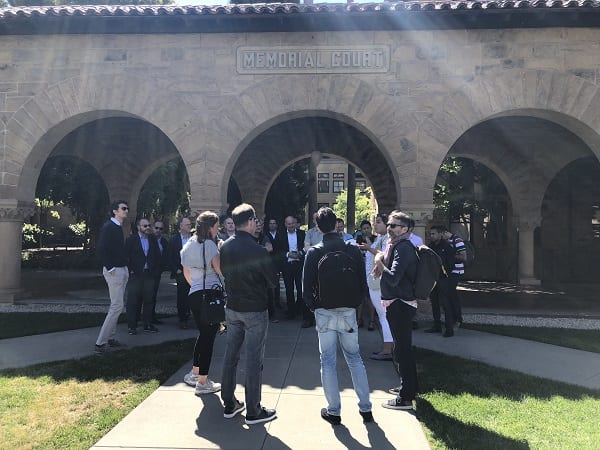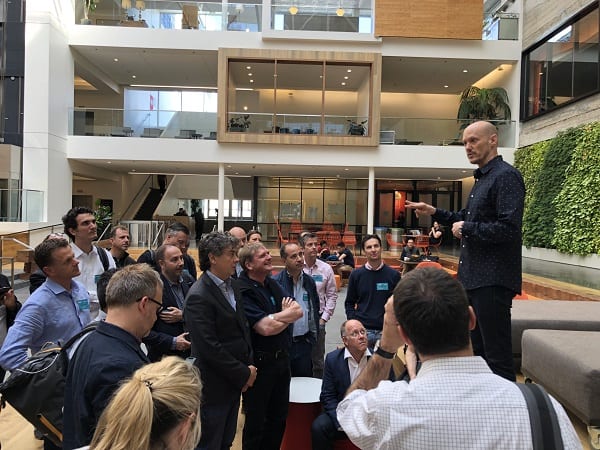For enterprise software maker SAP, coming to SIlicon Valley was all about learning how to innovate. The four-day trip was a chance to see up close how some of the world’s leading tech companies apply the principles of entrepreneurship to achieve remarkable results.
What’s more, SAP saw how the latest technologies are being applied to build the economy of the 21st century. It was an experience sure to prove invaluable as the European multinational continues to grapple with its own journey of digital transformation.
Day one of the tour served as a short introduction to the world of Silicon Valley; its culture and people. It began with a visit to the SLAC National Accelerator Laboratory at Stanford University. Here, the SAP team learned about the work being done with machine learning to read X-rays and reveal intimate details of atoms and electrons.
A tour of the Stanford campus shed light on the institution’s storied history. Often thought of as the spiritual home of Silicon Valley innovation, Stanford has gained a reputation as one of the world’s leading centers for spinning off new ventures, attracting start-up funding and commercializing university research.

Behind the Scenes
The days that followed gave SAP an insider’s view of Silicon Valley, including meetings with two of its biggest names: LinkedIn and Google.
At LinkedIn, the team found out how the social network turned itself into one of the world’s leading platforms for hiring. In the process, it has become a major player in the B2B ad space. With huge amounts of data at its fingertips from its 500 million users, LinkedIn is able to target ads to specific professional groups. Last year, the company generated $27 billion in revenue.
SAP received a behind-the-scenes look at LinkedIn’s culture as well as their hiring and management practices, all of which have helped the company become the clear leader in the professional networking industry.

Next, SAP had a chance to put their questions directly to the search engine giant, Google. Topics discussed ranged widely, everything from Google’s plans for artificial intelligence through to its corporate culture, revenue streams and policies on handling user data. SAP learned, for example, that Google generates 86% of its income through advertising and that employees are encouraged to use video conferencing so that their emotions are easily seen by colleagues. It was a meeting full of unique insights.
A Q&A with Cisco provided another point of view on digital transformation. The SAP executives were able to learn about the process as experienced by a legacy company not dissimilar in age and structure to their own. SAP listened in as Cisco discussed its strategies on how to pick startups to partner with, how to foster a culture of innovation and how to make the right hires. Cisco is perhaps the ideal Silicon Valley success story: founded in 1984 by two Stanford computer scientists, it is today still going strong as a multinational tech conglomerate with a long list of startup acquisitions under its belt. Its latest areas of work include Internet of Things and cloud computing.
Thinking differently
SAP’s Silicon Valley experience came to an end with a tour of Airbnb. This trip brought together many of the ideas explored on previous days. A classic tech story of disruption by a startup, Airbnb has rewritten the rules in the market for accommodation rentals, using the sharing economy and the rise of smartphone technology to grow bigger and more quickly than any of its initial venture investors could have hoped for.
Today Airbnb is renowned for its working culture. Seeing how the company functions on a day-to-day level – and how important this is for overall success – was a highlight for SAP. As Airbnb CEO Brian Chesky has written, “culture is what creates the foundation for all future innovation. If you break the culture, you break the machine that creates your products.”

After four days of immersion in Silicon Valley, the team from SAP went away inspired. It had been, as they put it, an opportunity to explore “outside of the box of your own office.” Seeing how other companies are doing things, the risks they are taking and the strategies they are employing to embrace digital provided unique perspectives which would otherwise have been unavailable.
As the SAP executives headed back to their respective offices, they did so with a deeper understanding of what it means to be agile and “fail fast”. Along with that was a newly found excitement to put such thinking into practice within their own teams and get creative when it comes to solving new challenges.
